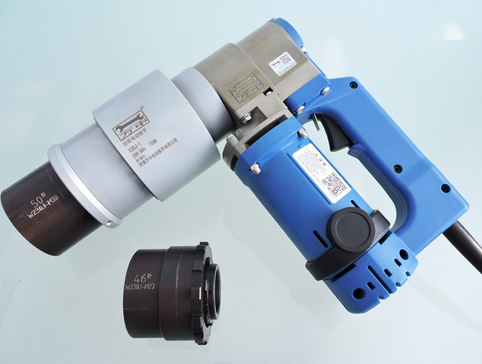扭剪螺栓该如何有效的拧紧呢?其紧固件螺纹拧紧法主要有扭矩法、转角法及扭矩斜率法三种常用的典型拧紧方法。1、扭矩法
How to effectively tighten the torsion shear bolt? There are three typical tightening methods, which are torque method, angle method and torque slope method. 1. Torque method
扭矩法就是利用扭矩与预紧力的线性关系在弹性区进行紧固控制的一种方法。该方法在拧紧时,只对一个确定的紧固扭矩进行控制,因此,因为该方法操作简便,是一种一般常规的拧紧方法。但是,由于紧固扭矩的90%左右作用于螺纹摩擦和支承面摩擦的消耗,真正作用在轴向预紧力方面仅10%左右,初始预紧力的离散度是随着拧紧过程中摩擦等因素的控制程度而变化的,因而该拧紧方法的离散度较大,适合一零件的紧固,不适合重要的、关键的零件的连接。
Torque method is a method of tightening control in elastic region by using the linear relationship between torque and preload. When tightening, this method only controls a certain tightening torque. Therefore, it is a general and conventional tightening method because it is easy to operate. However, about 90% of the tightening torque acts on the consumption of thread friction and bearing surface friction, and the actual effect is only about 10% of the axial pre tightening force. The dispersion of the initial pre tightening force changes with the control degree of friction and other factors in the tightening process. Therefore, this tightening method has a large dispersion, which is suitable for the fastening of a part, and is not suitable for the connection of important and key parts.
2、转角法
2. Corner method
转角法就是在拧紧时将螺栓于螺母相对转动一个角度,称之为紧固转角,把一个确定的紧固转角作为指标来对初始预紧力进行控制的一种方法。该拧紧方法可在弹性区和塑性区使用。根据紧固转角和预紧力的关系可知,Q-F曲线斜率急剧变化时,随着紧固转角的设定误差,预紧力的离散度也会变大。因此,在被连接件和螺栓的刚性较高的场合,对弹性区的紧固是不利的;对塑性区的紧固时,初始预紧力的离散度主要取决于螺栓的屈服点,而转角误差对其影响不大,故该紧固方法具有可限度地利用螺栓强度的优点(即可获得较高的预紧力)。
The angle method is to rotate the bolt to the nut by an angle, which is called tightening angle. A certain tightening angle is used as an index to control the initial pre tightening force. The tightening method can be used in elastic and plastic regions. According to the relationship between tightening angle and preload, when the slope of q-f curve changes sharply, the dispersion of preload will increase with the setting error of tightening angle. Therefore, when the rigidity of the connected parts and bolts is high, it is disadvantageous to the fastening in the elastic zone; when tightening in the plastic zone, the dispersion of the initial pre tightening force mainly depends on the yield point of the bolt, and the angular error has little effect on it. Therefore, the tightening method has the advantage of making full use of the bolt strength (i.e. obtaining a higher preload).

应该注意的是该拧紧方法在塑性区拧紧时会使螺栓的杆部以及螺纹杆部发生塑性变形,因此,对螺栓塑性差的以及螺栓反复使用的场合应考虑其适用性。另外,对预紧力过大,会造成被连接件受损的情况时,则必须对螺栓的屈服点及抗拉强度的上限值进行规定。
It should be noted that this tightening method will cause plastic deformation of the bolt rod and the threaded rod when tightening in the plastic zone. Therefore, the applicability of this method should be considered when the bolt has poor plasticity and is used repeatedly. In addition, the upper limit of yield point and tensile strength of bolts must be specified when the pre tightening force is too large, which will cause damage to the connected parts.
3、扭矩斜率法
3. Torque slope method
扭矩斜率法是以Q-F曲线中的扭矩斜率值的变化作为指标对初始预紧力进行控制的一种方法。该拧紧方法通常把螺栓的屈服紧固轴力作为控制初始预紧力的目标值。该拧紧方法一般在螺栓初始预紧力离散度要求较小并且可限度地利用螺栓强度的情况下使用。但是由于该拧紧方法对初始预紧力的控制与塑性区的转角法基本相同,所以,需要对螺栓的屈服点进行严格的控制。该拧紧方法与塑性区的转角法相比,螺栓的塑性即反复使用等方面出现的问题较少,有一定的优势,但是,紧固工具比较复杂,也比较昂贵。
Torque slope method is a method to control the initial preload with the change of torque slope value in q-f curve as an index. In this method, the yield tightening axial force of bolt is usually taken as the target value to control the initial preload. This tightening method is generally used when the discrete degree of bolt initial pre tightening force is small and the bolt strength can be used to a limited extent. However, because the control of the initial pre tightening force by this tightening method is basically the same as that of the rotation angle method in the plastic zone, the yield point of the bolt should be strictly controlled. Compared with the rotation angle method in plastic zone, this tightening method has less problems in the plasticity of bolts, i.e. repeated use, and has certain advantages. However, the tightening tools are more complex and expensive.
